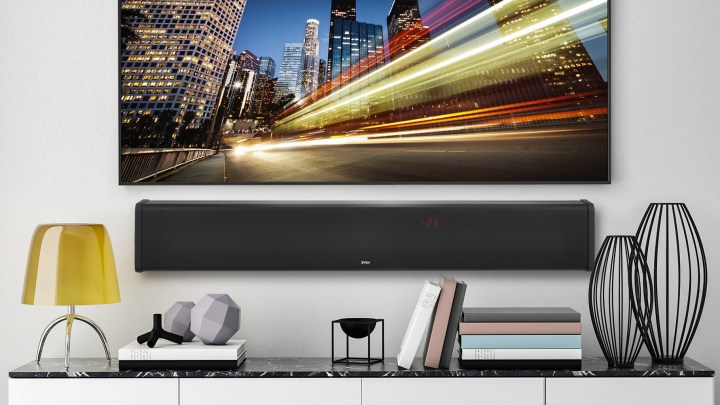

When Tom Hannaher designed and sold his first soundbar, he had no idea that his biggest fans would be the hard of hearing.
It was 2003, and he had just started a small audio company called Zvox after years of working at Cambridge Soundworks in Boston. Aiming to create a small form-factor, great-sounding speaker to pair with TVs, Hannaher’s new company had built a rectangular speaker to place below TVs. It would eventually become recognized by industry experts as the first commercially successful soundbar.
People didn’t care about surround sound or bass … they just couldn’t understand what was being said on TV.
Building the first successful product in a now-expansive product category is a massive achievement, and much of the success is owed to the fact that Zvox’s model was designed to replicate higher-end systems with dedicated speakers.
The original Zvox soundbar had a center speaker explicitly designed for vocal dialogue, mirroring discrete home theater speaker setups, meaning that the voices on screen rise above other sound effects from a particular show or film when reproduced on the Zvox soundbar.

After some slow sales in the beginning (understandable given how new the product category was) those with hearing issues – mostly elderly buyers — caught wind of this little speaker that made their favorite TV shows easier to understand.
“Early on, we realized that what we were selling as a home theater system, people were purchasing as a dialogue clarification system,” says Hannaher. “People didn’t care about surround sound or bass … they just couldn’t understand what was being said on TV.”
Hannaher and his company had tapped into an unanticipated market and they did everything they could to keep it. The team of engineers and developers spent the intervening years working on making both hardware and software improvements to their soundbars, creating what they call the AccuVoice feature for those who are hard of hearing or want maximum clarity from the on-screen dialogue.
“It’s really a crazy combination of good,” he says, “… we built a hearing aid into a loudspeaker.”
AccuVoice technology, which has since been patented by the company, is able to manipulate the dialogue signal from a speaker without changing the background sounds in any given scene. This means the hearing impaired can turn up the dialogue without turning up the background noise, revolutionizing the way people with hearing loss can experience TV and film programming.
For Hannaher, the decision to focus his company on improving the listening lives of the hearing impaired has personal context. His father was in the artillery in World War II, and by the time he was 60, he was really hard of hearing. When his father was older, he put quality speakers on every TV he owned, which allowed him to turn down the volume from what he described as “marriage-breaking” volume.
The response to AccuVoice from buyers has been spectacular — beyond what Hannaher ever expected when originally launching his company to create great-sounding, compact home theater speakers. After all, Zvox is providing listeners with a quality-of-life improvement that goes beyond a simple audio upgrade.
Zvox is aiming to help those with hearing loss using the same technology in its AccuVoice soundbars.
“We got this handwritten letter, sent by snail mail, [from a senior citizen] and it talked about how he got his Zvox system, hooked it up, sat down and watched a movie with his wife. He turned to look at his wife and she was crying. He said, ‘What’s the matter?’ and she said, ‘Nothing’s the matter. I just took out my hearing aids and I can still hear what they’re saying!’”
“We understood for the first time how it can feel to make a product that … solves a problem,” Hannaher adds. “It’s way more fun to sell that than to sell a subwoofer that goes down to 28Hz.”

In the intervening period, Zvox has expanded upon its life-improving ambitions by developing and selling its own hearing aids for significantly below average pricing, aiming to help those with mild to moderate hearing loss with the same technology it developed for its AccuVoice soundbars. With the introduction of the Hearing Aid Act, which was signed into law in 2017 and will go into effect by August of 2020, Zvox will be allowed to sell outside of licensed clinics, making it even easier to get corrective technology for those with mild to moderate hearing loss.
Feedback on the hearing aids (which are only sold directly from the company’s website until the law goes into effect) has been stellar so far — the company even got a letter from a retired ENT doctor in Florida complimenting them on their product.
“We thought that was very cool,” Hannaher chuckles.
The company has also recently launched its first pair of headphones, the AccuVoice AV50, a noise-canceling headphone designed to help listeners hear TV and podcast dialogue more clearly.
After over a decade making products that appeal to the hard of hearing, Zvox has made a name for itself in an especially important market, but that doesn’t mean the company wants to see the need for products for the hard of hearing grow.
During our conversation, Hannahar talks about how he wishes more people were aware of the dangers and causes of hearing loss, and hopes that more people will consider lowering volume (and wearing earplugs at concerts) to avoid it.
“One of our engineers has been wearing [earplugs] for years now,” he says, “And his ears, when he turns my age, are going to be in way better shape than mine.”



